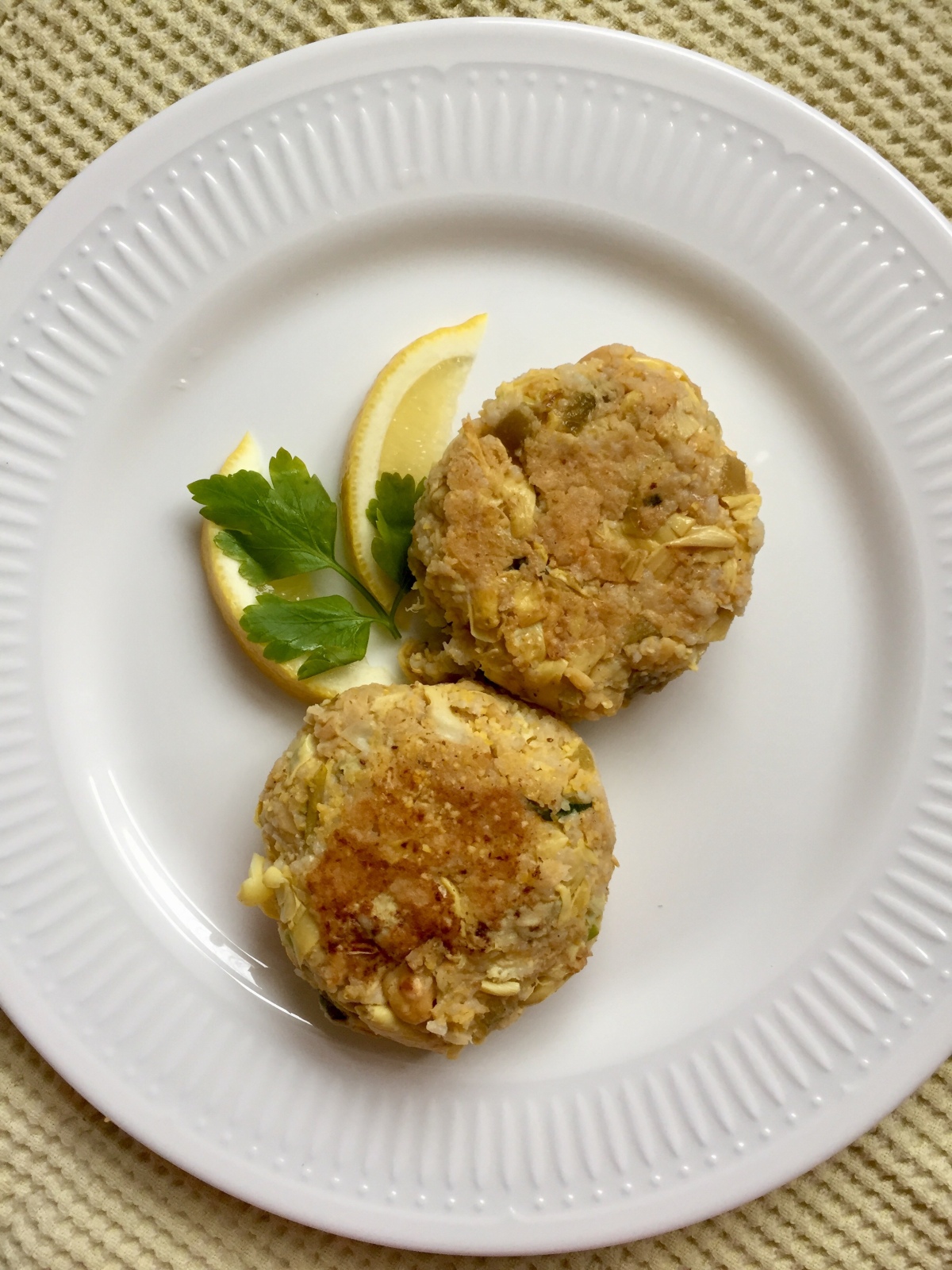
I was debating whether I should call these crab cakes or fish cakes – I suppose at the end of the day the name does not matter as much as the flavor. And the flavor here is fresh, citrusy, and the texture is flaky. So, to me these are more like fish cakes than crab cakes, but not matter what you decide to call them these will be your new favorites.
These are fantastic appetizer bites, suitable for any party, and they come together in no time at all. All you need is two cans of artichoke hearts and a can of chickpeas, plus a bit of seasoning and filler stuff (like breadcrumbs and/or corn meal), and a healthy amount of lemon – and you will be cruising.
The recipe is also flexible – if you don’t like corn meal you can just double the panko (but I do suggest you give corn meal a try because the flavors are just a bit different and more nutty, and the surface gets a bit crustier). And if you need to keep things gluten-free, go with gluten-free panko that now seems to be widely available in grocery stores.
I used Old Bay Seasoning as the main flavoring ingredient because I associate it with seafood and fish – but you can use other spices, like dill (fresh or dried), celery seed powder (or celery salt), and customize according to your preferences. I also added a bit of mild heat by using a small can of fire roasted green chili peppers. Here, you also have an option to replace with jalapeños, for more heat, or skip heat altogether and add a bit of sweet roasted red peppers. What ever you decide to do, you only need a small amount of it – you are going for just a bit of a surprise here; otherwise flavors can get overwhelming quickly.
If you are counting calories and fat, you can also skip the mayo. I use it as a binder, but a spoonful of mustard or a spoonful of unsweetened plain nut milk or yogurt, or even water will do the trick as well.
So, by now you are thinking that you can probably replace absolutely everything and still be OK. Well, you should not, and I repeat not, compromise on lemon. Lemon juice and especially the lemon zest will add so much to these cakes that you must include them.
Another two things that you must do is mash the chickpeas with your hands or the potato masher (but do leave some whole), and then, when all the ingredients are in, let the mix rest for a while. This will help all the flavors come together, as well as the mix bind, so you will be able to make the cakes more easily.
Why use sliced artichoke hearts? That gives the whole thing the flaky texture (you can use jackfruit here, as well as banana blossom – but I bet that for most of you artichoke hearts are much easier to find!). Why use chickpeas? To add structure and protein, so if you don’t like chickpeas you could use white beans. In that case you probably will not need to add extra mayo as suggested in the recipe, since beans tend to add more moisture.
With all these options, and dos and don’ts, hopefully the last part will be easy. The rest is easy – make the cakes by using about a quarter of a cup at a time, and brown nicely in some oil or cooking spray. If you have an exceptionally good non-stick pan, you may get away without using any oil, but these are still delicate fish cakes, so they need to be handled with care.
The best way to enjoy them is with a spoonful of tartar sauce, or just pickle relish, or chopped fresh parsley.
Fish-like Cakes with Chickpeas and Artichoke Hearts
What you’ll need:
- 2 14.1 oz (400 g) cans of artichoke hearts, drained and sliced
- 1 15.5 oz (440 g) chickpeas, drained and rinsed
- 3 scallions, white and green sections, thinly sliced
- 1 teaspoon Old Bay Seasoning
- 1 teaspoon celery powder
- 1 cup corn meal
- 1 cup panko Japanese-style bread crumbs (gluten-free if desired)
- 1/4 cup vegan mayo
- 1 4 oz (113 g) can fire roasted green chiles, completely drained
- 1/2 lemon, juice and zest
- Cooking spray
What you’ll do:
- Drain the artichoke hearts, squeeze the excess liquid out of them, then slice thinly.
- Place chickpeas into a large mixing bowl and mash until most of the chickpeas are fully smashed.
- Add sliced artichoke hearts, sliced scallions, and the rest of the ingredients and mix well until everything is well combined. Leave the mixture to soak for 30-45 minutes.
- Using your hands, scoop about 1/3 cup of the mixture and make it into a patty, about 1/2 in (1 cm) thick. Place the patties on a plate – this mixture makes about 10-12 patties.
- Place a large pan over high heat, spray with cooking spray and add 4-5 patties at a time. Cook for about 4-5 minutes per side, until golden brown.
- Serve with some lemon juice, vegan tartar sauce, and/or fresh parsley!
Version note: this post has been updated to correct some spelling/writing errors. One of the readers noted that in several instances word “panko” was autocorrected into the word “panic”. And although some panic while cooking is unavoidable, I have now corrected this mistake. Cheers!
Copyright © Eat the Vegan Rainbow, 2019












































